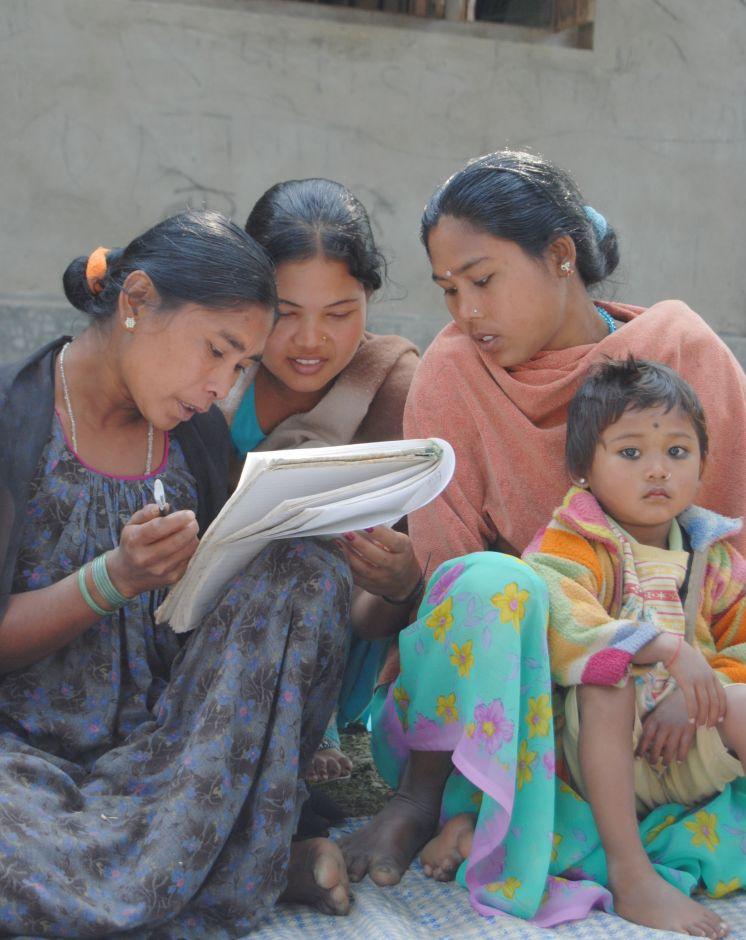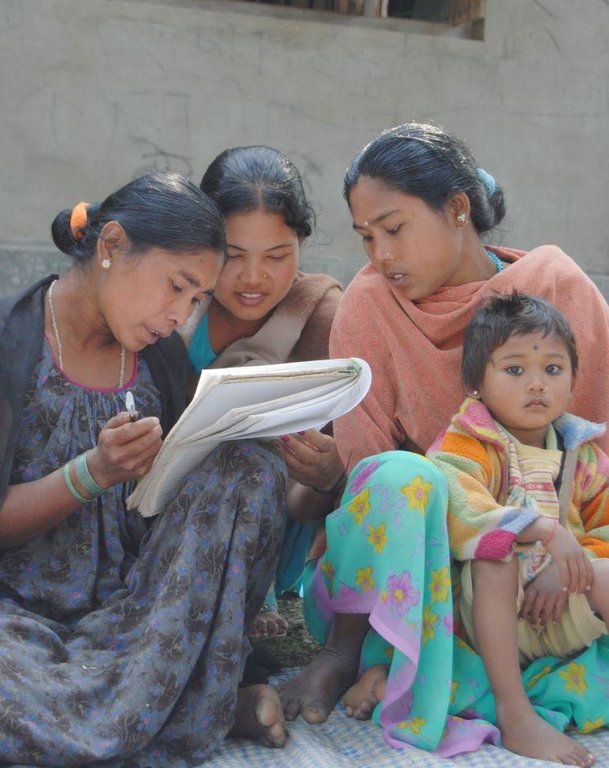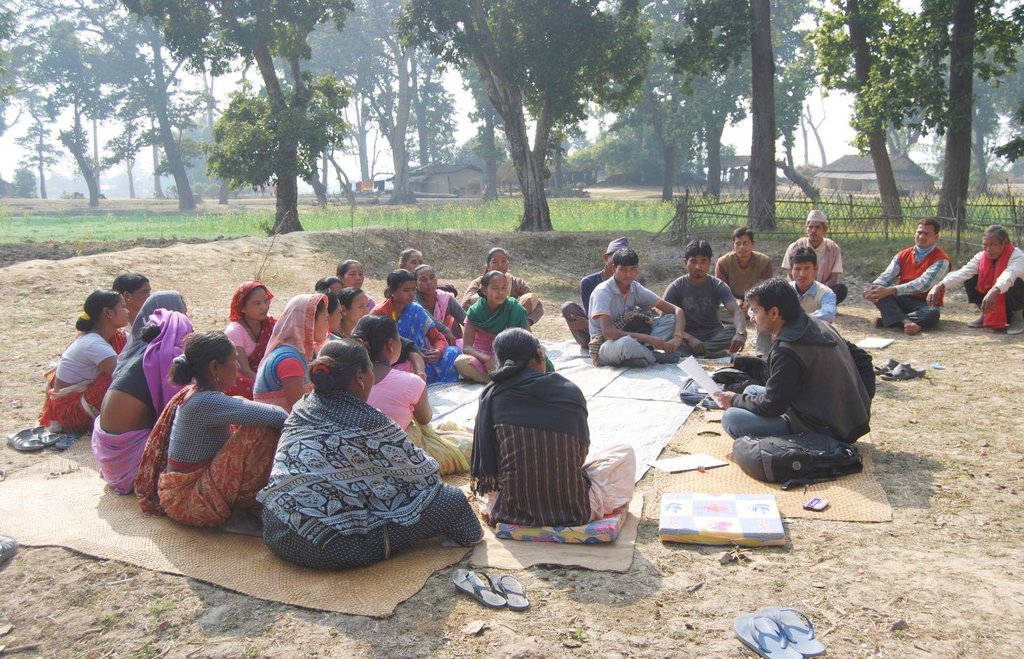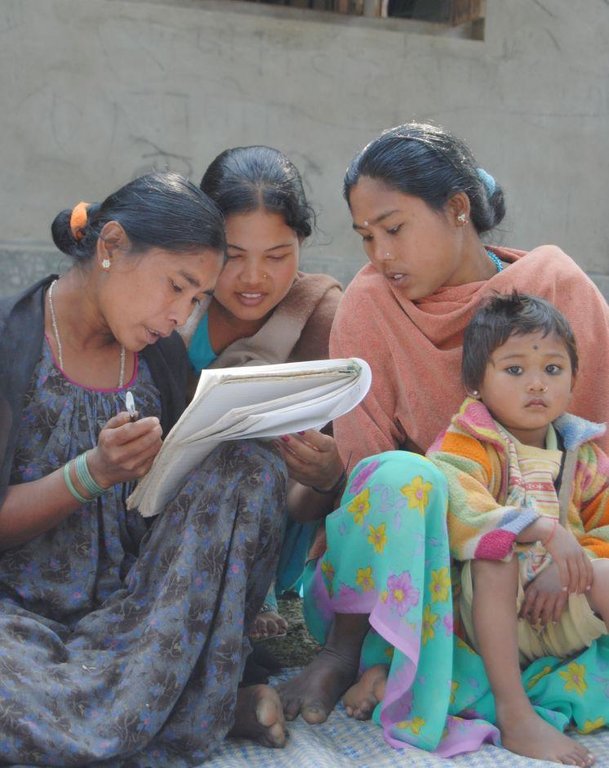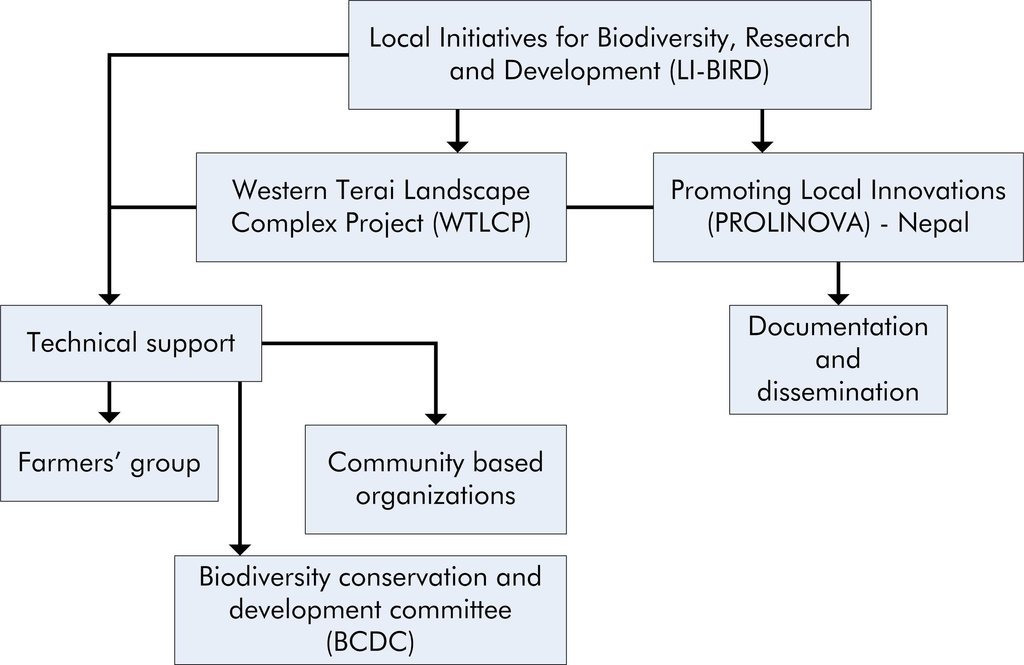Learning about no-till methods through farmer-to-farmer dissemination [尼泊尔]
- 创建:
- 更新:
- 编制者: Shreedip Sigdel
- 编辑者: –
- 审查者: Fabian Ottiger
Kisan - Kisan bichko prasal dwara khanjot nagarikana kheti garne tarika ko addhyan (Main Contributor: Krishna Lamsal, LI-BIRD)
approaches_2531 - 尼泊尔
查看章节
全部展开 全部收起1. 一般信息
1.2 参与方法评估和文件编制的资源人员和机构的联系方式
SLM专业人员:
SLM专业人员:
Lamsal Krishan
+977 61 5535357/5526834 / 9841483937 (M)
naturekrish@gmail.com / klamsal@libird.org,
Local Initiatives for Biodiversity, Research and Development (LI-BIRD)
P.O.Box 324, Gairapatan, Pokhara
尼泊尔
有助于对方法进行记录/评估的机构名称(如相关)
ICIMOD International Centre for Integrated Mountain Development (ICIMOD) - 尼泊尔有助于对方法进行记录/评估的机构名称(如相关)
Kathmandu University (KU) - 尼泊尔有助于对方法进行记录/评估的机构名称(如相关)
Local Initiatives for Biodiversity, Research, and Development (LI-BIRD) - 尼泊尔1.3 关于使用通过WOCAT记录的数据的条件
(现场)数据是什么时候汇编的?:
01/03/2013
编制者和关键资源人员接受有关使用通过WOCAT记录数据的条件。:
是
1.4 SLM技术问卷的参考
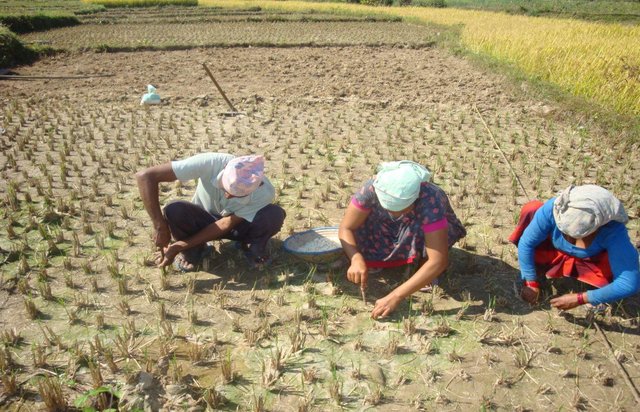
No-till garlic cultivation [尼泊尔]
No-till is a farming system in which the seeds are planted directly into untilled soil which still contains the previous crop residues. No-till cultivation of garlic is practiced in the tropical lowland districts of western Nepal where garlic is sown directly into the soil after the paddy is harvested.
- 编制者: Shreedip Sigdel
2. SLM方法的描述
2.1 该方法的简要说明
Farmer to farmer dissemination of information on no-till methods for garlic cultivation technology
2.2 该方法的详细说明
该方法的详细说明:
Aims / objectives: Farmers can learn about alternative or newer methods by sharing their experiences with one another. In this approach, farmers shared information and knowledge on no-till garlic cultivation technology.
Methods: Since no-till methods are not widely known in the area, the approach aimed to increase awareness of the many features of the technique and its benefits. Through farmer-to-farmer dissemination, communities can learn about the various aspects of no-till for crop residue management, resource use, and how it can reduce labour costs. These discussions highlight the environmental and social benefits of no-till methods especially with respect to moisture retention, soil and water conservation, and climate change adaptation.
In 2009, Local Initiatives for Biodiversity, Research, and Development (LI-BIRD), piloted and validated no-till farming in Nepal as a measure for soil and water conservation through the Western Terai Landscape Complex Project (WTLCP) and the Promoting Local Innovation (PROLINNOVA) programme. The dissemination was multi-faceted and the farmers remained engaged throughout the discussions, which included both talks and group participation. Farmers’ groups, community-based organizations, biodiversity conservation groups, and development committees at the village level were given training and technical inputs. This community-level interaction encouraged farmers to discuss with one another as well as to head out to the field for demonstrations and observations. After no-till garlic cultivation was successfully piloted, it was widely adopted by farming communities and especially the indigenous Tharu communities of western Nepal.
2.3 该方法的照片
2.5 采用该方法的国家/地区/地点
国家:
尼泊尔
有关地点的进一步说明:
Gadariya VDC, Kailali District
2.6 该方法的开始和终止日期
注明开始年份:
10
2.7 方法的类型
- 最近的本地倡议/创新
2.8 该方法的主要目的/目标
The Approach focused mainly on SLM with other activities (agricultural and livelihood related technology)
• To disseminate information and know-how on no-till methods
• To increase awareness among the farmers on the benefits of no-till methods and crop residue management
• To increase awareness of the environmental and social benefits of no-till methods and the role that it can play in adaptation to climate change
The SLM Approach addressed the following problems: • Lack of awareness about low cost soil and water conservation technologies that address farmers' needs
• Initially there was weak institutional support for organizing discussion sessions
2.9 推动或妨碍实施本办法所适用的技术的条件
社会/文化/宗教规范和价值观
- 阻碍
No-till methods are not widely known in the area
Treatment through the SLM Approach: The group was readily convinced of the economic benefits of no-till methods (especially for garlic production) and this was essential in persuading them to accept the technology.
财务资源和服务的可用性/可得性
- 阻碍
Financial resources lacking; this group does not have links to financial institutions.
Treatment through the SLM Approach: Farmers used their own resources
其他
- 阻碍
Water availability is poor.
Treatment through the SLM Approach: No-till methods help to conserve moisture in the soil.
3. 相关利益相关者的参与和角色
3.1 该方法涉及的利益相关者及其职责
- 当地土地使用者/当地社区
Community based organization, farmers group
About 60% of those who attend meetings are women. Most of the field activities such as planting and harvesting are performed by women. The indigenous Tharu communities are adopting this technology.
- NGO
LI-BIRD
3.2 当地土地使用者/当地社区参与该方法的不同阶段
| 当地土地使用者/当地社区的参与 | 指定参与人员并描述活动 | |
|---|---|---|
| 启动/动机 | 自我动员 | Community meetings organized to discuss the new technology and how it could be implemented locally |
| 计划 | 互动 | Interactive discussion groups and focal groups organized in the community |
| 实施 | 自我动员 | Individual farmers implemented the technology on their land without external support. LI-BIRD provided in-kind and technical information and support. |
| 监测/评估 | 自我动员 | LI-BIRD monitored the implementation of the technology and helped to evaluate the outcome. They collected and analysed data in order to highlight the soil and water conservation aspects of the no-till method and disseminated this information. |
| Research | 无 |
3.3 流程图(如可用)
具体说明:
LI-BIRD piloted and validated no-till farming in Nepal as a measure for soil and water conservation through the Western Terai Landscape Complex Project (WTLCP) and the Promoting Local Innovation (PROLINNOVA) programme. Technical support was extended to farmers’ groups, community-based organizations, biodiversity conservation groups, and development committees at the village level.
作者:
(A. K. Thaku)
3.4 有关SLM技术选择的决策
具体说明谁有权决定选择要实施的技术:
- 主要是土地使用者,由SLM专家提供支持
解释:
Decisions on the method of implementing the SLM Technology were made by mainly by land users supported by SLM specialists
4. 技术支持、能力建设和知识管理
4.1 能力建设/培训
是否为土地使用者/其他利益相关者提供培训?:
是
明确受训人员:
- 土地使用者
如果相关,请说明性别、年龄、地位、种族等。:
Land users and community mobilizers from the indigenous Tharu communities were given training on no-till method and crop residue management.
培训形式:
- 示范区域
培训形式:
- Participatory methods and approaches
4.2 咨询服务
土地使用者有权使用咨询服务吗?:
是
指明是否提供了咨询服务:
- 在固定中心
说明/注释:
Name of method used for advisory service: Capacity building training; Key elements: Capacity building took place through site visits and extension materials as well as through discussions and exchanges
4.3 机构强化(组织发展)
是否通过这种方法建立或加强了机构?:
- 是,适度
具体说明机构的强化或建立程度:
- 本地
具体说明支持类型:
- 能力建设/培训
- Technical support
提供进一步细节:
LI-BIRD supported farmers groups, biodiversity conservation and development committees, and community-based organizations by providing hands-on training and technical support.
4.4 监测和评估
监测和评估是该方法的一部分吗?:
是
注释:
technical aspects were regular monitored by project staff, government, land users through observations; indicators: Regular observations by technical staff from LI-BIRD jointly with representatives from biodiversity conservation and development committees, farmers groups, and community-based organizations
socio-cultural aspects were regular monitored by project staff, land users through observations; indicators: Regular observations by technical staff from LI-BIRD jointly with representatives from biodiversity conservation and development committees, farmers groups, and community-based organizations
economic / production aspects were regular monitored by project staff, government, land users through observations
economic / production aspects were monitored by None through measurement
There were several changes in the Approach as a result of monitoring and evaluation: Several changes were observed. People learned both through discussions and by taking a hands-on approach. An initial attempt to replicate the method ended in failure. However, through discussions and technical inputs, the farmers were eventually able to replicate the method and it is now well understood.
5. 融资和外部物质支持
5.1 该方法中SLM组成部分的年度预算
注释(例如主要的资助来源/主要捐助者):
Approach costs were met by the following donors: local community / land user(s) (Mostly by the land users; capacity building activities and field demonstration costs were borne by LI-BIRD.): 100.0%
5.2 为土地使用者提供财政/物质支援
土地使用者是否获得实施该技术的财政/物质支持?:
否
5.3 对特定投入的补贴(包括劳动力)
- 无
5.4 信用
是否根据SLM活动的方法给予信用值?:
否
6. 影响分析和结论性陈述
6.1 方法的影响
该方法是否帮助土地使用者实施和维护SLM技术?:
- 否
- 是,很少
- 是,中等
- 是,支持力度很大
No-till and better use of crop residues has contributed to improved land management; more moisture is now retained in the soil. Water is in poor supply and vegetable production in this area is limited by the amount of moisture in the soil.
该方法是否有助于社会和经济弱势群体?:
- 否
- 是,很少
- 是,中等
- 是,支持力度很大
The indigenous Tharu communities now have some increased cash income from selling their garlic crop.
Did other land users / projects adopt the Approach?
- 否
- 是,很少
- 是,中等
- 是,支持力度很大
Community-based organizations, as well as members of other communities and neighbouring districts, have either adopted the method or expressed an interest in learning how to implement it.
Did the Approach lead to improved livelihoods / human well-being?
- 否
- 是,很少
- 是,中等
- 是,支持力度很大
Mainly due to increased income from garlic production and reduced labour costs associated with no-till.
Did the Approach help to alleviate poverty?
- 否
- 是,很少
- 是,中等
- 是,支持力度很大
mainly due to increased income from garlic production and reduced labour costs. Studies showed a 25% increase in crop yield and reduced labour requirements.
6.2 土地使用者实施SLM的主要动机
- 增加利润(能力),提高成本效益比
- 减少工作量
- well-being and livelihoods improvement
6.3 方法活动的可持续性
土地使用者能否维持通过该方法实施的措施(无外部支持的情况下)?:
- 是
若是,请说明如何维持:
This technology has a high probability of being sustainable because it is cost effective and requires minimal technical input (farmers can do it on their own); moreover, it helps with soil conservation.
6.4 该方法的长处/优点
| 编制者或其他关键资源人员认为的长处/优势/机会 |
|---|
| Farmers can easily learn no-till techniques through community participation. The approach is sustainable because it is easy to implement and it appeals to farmers because they appreciate it as a way of reducing labour and increasing crop yields. (How to sustain/ enhance this strength: Continue to give some minor technical support and encouragement.) |
| The approach focused on building capacity by using a hands-on approach similar to how farmers traditionally transfer know-how between themselves. Farmers can adapt and modify the technology as needed to deal with changing conditions in the environment. Financial inputs by external organizations are not needed. (How to sustain/ enhance this strength: Continue to give some minor technical support and encouragement.) |
6.5 该方法的弱点/缺点以及克服它们的方法
| 编制者或其他关键资源人员认为的弱点/缺点/风险 | 如何克服它们? |
|---|---|
| Market linkages are poor and the scope to scale up is also small. | The establishment of stronger market linkages would motivate farmers to attempt commercial cultivation. |
7. 参考和链接
7.1 方法/信息来源
- 实地考察、实地调查
- 与土地使用者的访谈
链接和模块
全部展开 全部收起链接

No-till garlic cultivation [尼泊尔]
No-till is a farming system in which the seeds are planted directly into untilled soil which still contains the previous crop residues. No-till cultivation of garlic is practiced in the tropical lowland districts of western Nepal where garlic is sown directly into the soil after the paddy is harvested.
- 编制者: Shreedip Sigdel
模块
无模块


